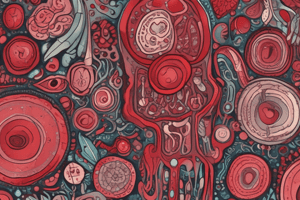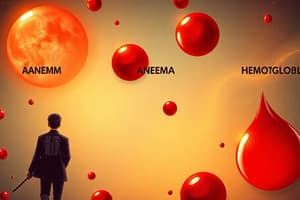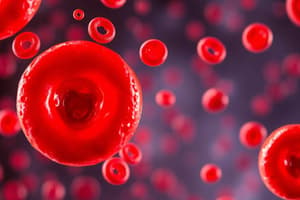Podcast
Questions and Answers
What happens to the erythrocytes during elevated Erythrocyte Sedimentation Rate (ESR)?
What happens to the erythrocytes during elevated Erythrocyte Sedimentation Rate (ESR)?
- They tend to clump together, resulting in a faster sedimentation rate. (correct)
- They distribute evenly, creating a consistent sedimentation rate.
- They become smaller, leading to a faster sedimentation rate.
- They become larger, causing a slower sedimentation rate.
What is a characteristic of venous circulation in patients with sluggish blood flow?
What is a characteristic of venous circulation in patients with sluggish blood flow?
- The blood is oxygenated and appears bright red.
- The blood vessels are dilated, resulting in a lower blood pressure.
- The blood flow is increased, leading to a faster sedimentation rate.
- The blood is deoxygenated and appears dark bluish. (correct)
What is a potential cause of a low Erythrocyte Sedimentation Rate (ESR)?
What is a potential cause of a low Erythrocyte Sedimentation Rate (ESR)?
- Abnormally shaped red blood cells. (correct)
- Inflammation in the body.
- Anemia.
- Pregnancy.
Which of the following factors can decrease the Erythrocyte Sedimentation Rate (ESR)?
Which of the following factors can decrease the Erythrocyte Sedimentation Rate (ESR)?
Which of the following is NOT a characteristic of polycythemia?
Which of the following is NOT a characteristic of polycythemia?
How does inflammation affect the Erythrocyte Sedimentation Rate (ESR)?
How does inflammation affect the Erythrocyte Sedimentation Rate (ESR)?
What does the Erythrocyte Sedimentation Rate (ESR) directly measure?
What does the Erythrocyte Sedimentation Rate (ESR) directly measure?
What is the normal PCV range for males?
What is the normal PCV range for males?
What is a primary cause of aplastic anemia?
What is a primary cause of aplastic anemia?
What condition leads to deficiencies in Vitamin B12 or folic acid?
What condition leads to deficiencies in Vitamin B12 or folic acid?
Which of the following is NOT a cause of hemolytic anemia?
Which of the following is NOT a cause of hemolytic anemia?
What circulatory effect occurs as a result of anemia?
What circulatory effect occurs as a result of anemia?
Which type of anemia is characterized by fragile red blood cells due to heredity?
Which type of anemia is characterized by fragile red blood cells due to heredity?
What is a common response of the body to compensate for anemia?
What is a common response of the body to compensate for anemia?
What role does marrow transplantation play in treating aplastic anemia?
What role does marrow transplantation play in treating aplastic anemia?
Which of these conditions is linked to autoimmune response in anemia?
Which of these conditions is linked to autoimmune response in anemia?
What is the primary characteristic of primary polycythemia?
What is the primary characteristic of primary polycythemia?
What physiological response occurs in secondary polycythemia?
What physiological response occurs in secondary polycythemia?
What could indicate a patient has polycythemia vera?
What could indicate a patient has polycythemia vera?
How does polycythemia affect blood circulation?
How does polycythemia affect blood circulation?
What is a common characteristic of individuals suffering from polycythemia?
What is a common characteristic of individuals suffering from polycythemia?
What occurs to blood pressure in polycythemia as a result of increased resistance?
What occurs to blood pressure in polycythemia as a result of increased resistance?
What is the typical RBC count for a person with secondary polycythemia?
What is the typical RBC count for a person with secondary polycythemia?
How many patients with polycythemia are generally normotensive?
How many patients with polycythemia are generally normotensive?
Flashcards
Aplastic Anemia
Aplastic Anemia
A condition where the bone marrow fails to produce enough blood cells, leading to a deficiency in red blood cells, white blood cells, and platelets.
Megaloblastic Anemia
Megaloblastic Anemia
A type of anemia caused by a deficiency in folate or vitamin B12, leading to the formation of large, abnormal red blood cells.
Hemolytic Anemia
Hemolytic Anemia
Occurs when red blood cells are destroyed prematurely, leading to anemia.
Sickle Cell Anemia
Sickle Cell Anemia
Signup and view all the flashcards
Immune-mediated Hemolysis
Immune-mediated Hemolysis
Signup and view all the flashcards
Erythroblastosis Fetalis
Erythroblastosis Fetalis
Signup and view all the flashcards
Decreased Blood Viscosity
Decreased Blood Viscosity
Signup and view all the flashcards
Circulatory Effects of Anemia
Circulatory Effects of Anemia
Signup and view all the flashcards
Packed Cell Volume (PCV)
Packed Cell Volume (PCV)
Signup and view all the flashcards
Erythrocyte Sedimentation Rate (ESR)
Erythrocyte Sedimentation Rate (ESR)
Signup and view all the flashcards
Rouleaux Phenomena
Rouleaux Phenomena
Signup and view all the flashcards
Disc-shaped RBCs
Disc-shaped RBCs
Signup and view all the flashcards
Polycythemia
Polycythemia
Signup and view all the flashcards
Anemia
Anemia
Signup and view all the flashcards
Spherocytosis
Spherocytosis
Signup and view all the flashcards
Primary polycythemia
Primary polycythemia
Signup and view all the flashcards
Secondary polycythemia
Secondary polycythemia
Signup and view all the flashcards
Blood viscosity
Blood viscosity
Signup and view all the flashcards
Arterial pressure
Arterial pressure
Signup and view all the flashcards
Venous return
Venous return
Signup and view all the flashcards
Cardiac output
Cardiac output
Signup and view all the flashcards
Hematocrit
Hematocrit
Signup and view all the flashcards
Study Notes
Aplastic Anemia
- Occurs when bone marrow function fails, stopping blood cell production.
- Causes include radiation, chemotherapy, toxins, autoimmune diseases, and unknown reasons (idiopathic).
- Treatment involves bone marrow transplantation or blood transfusions (donor-recipient matching is essential).
Megaloblastic Anemia
- Caused by decreased folic acid or vitamin B12.
- Reasons for deficiency include pernicious anemia, dietary insufficiency, and malabsorption.
- Deficiency impairs DNA replication, leading to maturation failure of blood cells.
- Characterized by large, fragile cells with unusual shapes, which rupture easily.
Hemolytic Anemia
- A hereditary condition causing RBC fragility.
- Two types are hereditary spherocytosis and sickle cell anemia.
- Immune-mediated destruction can occur, such as mismatched blood transfusions or erythroblastosis fetalis (mother-fetus mismatch).
- Antibodies and cells with antigens lead to RBC destruction.
Circulatory Effects of Anemia
- Blood viscosity decreases.
- Oxygen-carrying capacity decreases.
- Body compensates by increasing heart rate and vasoconstriction.
- Cardiac output increases, making exercise more difficult and potentially leading to rapid fatigue and pain.
- Pale-yellowish complexion and dark eye-bags may be present.
Polycythemia
- Characterized by increased RBC count.
- Two types:
- Primary (polycythemia vera): Bone marrow problem causes increased RBC production.
- Secondary: Physiological response to conditions like high altitude, hypoxia, lung or heart issues.
- Increased RBCs lead to higher blood viscosity, which in turn increases blood pressure (in some cases)
- Higher blood viscosity slows venous return which can lead to a venous circulation that is deoxygenated.
- Dark bluish color of venous plexus can occur with slower blood flow.
Laboratory Studies for Anemia
- Packed Cell Volume (PCV): Measures RBC count (higher numbers indicate polycythemia or dehydration; lower values indicate anemia). Normal ranges differ between genders.
- Erythrocyte Sedimentation Rate (ESR): Non-specific test for inflammation (higher ESR values indicate inflammation).
Osmotic Fragility
- Important in spherocytosis, assessing RBC cell flexibility and resistance to changing fluid volume.
- Diluted solutions (hypotonic) are used in testing methods.
- Cells will swell and potentially burst at differing degrees of dilution (different concentrations), based on their resistance .
- Percentage of surface area to cell volume dictates fragility. Larger surface to volume ratios lead to higher fragility.
- Lower surface to volume ratio indicates cells with greater toughness (a higher resistance).
Hemostasis
- Process of preventing blood loss.
- Platelets perform coagulation. Platelets change blood consistency from a liquid to a gel-like state, stopping bleeding.
- Creating a network in the injured area to draw the sides together to promote healing/regeneration.
- Vascular constriction (reducing blood flow) is an initial step of this process, followed by the activation of platelets to form a plug and clot formation.
- The tissue factor (released from tissue in injury site) further accelerates platelet activation and blood clotting processes in a trauma response.
Studying That Suits You
Use AI to generate personalized quizzes and flashcards to suit your learning preferences.




